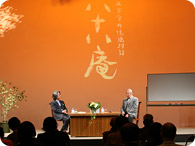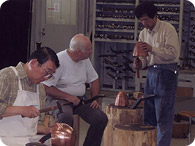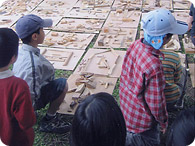Lifelong Learning Center

The Lifelong Learning Center began operations in April 2000. It aims to enrich the artistic lives of the general public by making the extensive facilities of Tama Art University available to people of all ages.
Principles

At the present time, a university must provide not only an advanced education in the traditional sense, but additional public services such as educational programs for working people, and lifelong learning programs. TAU believes that everyone has innate creative ability of some kind, and consequently takes these added responsibilities extremely seriously. The appreciation and creation of art involves visualization, thought, observation, touch, emotion, imagination, and the pleasure of creating something. Art is a special and rewarding activity available to all. While enjoying the pursuit of a new interest, people can discover their hidden talents and uncover a whole new world. In our rapidly changing urban society, in which people can easily lose their sense of values, we aim to provide ample opportunities for sharing different viewpoints through creative activities. In short, the aim of the TAU Lifelong Learning Center is to fully exploit the potential of present and future generations.
Activities

Making good use of the educational resources, facilities, and networks provided by TAU, the Lifelong Learning Center has been steadily expanding its range of activities. It offers a wide variety of courses including lectures and workshops, and under the guidance of the center, the Kaminoge and Hachioji campuses offer about 150 courses each year. University departments collaborate to present a range of lectures, workshops, and research activities with multi-field themes. Also, programs based on a single keyword such as "city" or "landscape" approach the keyword from different perspectives. Art appreciation is taught by TAU faculty members and other instructors. Regarding course duration, the center offers one-off, one-year courses as well as courses that run over several years. In compliance with the wishes of all participants, daytime and nighttime courses are provided on weekdays and weekends, and the application system is simple and tailored to the needs of all.
Characteristics
-
Programs covering a wide spectrum of art
Programs are designed to include a full range of artistic activities related to life beyond the conventional frame of fine arts. -
Holistic approaches to the core values of art
Programs adopt a compound approach, examining the core values of art by offering a combination of lectures and workshops and encouraging collaborative work in different fields. -
Open to all
Regardless of age, occupation and artistic experience, all programs are open to the public. Since we focus on the importance of pre-school and elementary education, a number of programs are provided for children. -
Suitable for participants who are newly interested in art
We place special emphasis on programs for learners who want to study art for the first time. In order to expose them to art and expand their worlds, the programs give many enjoyable opportunities for students to exercise their imagination, expand their abilities to appreciate art, and to produce works. -
Culture base for the local community
The continuing education programs draw on the close ties between Tama Art University and local areas. It is important for us to communicate with local people in order to establish mutual understanding and contribute to the local community. -
Off-campus courses for those outside the metropolitan area
The center arranges off-campus courses in cooperation with municipalities and provincial schools for the spread of artistic education.
Prospects
With the aim of opening new channels of communication between the university and all sections of society with an interest in visual expression, the Lifelong Learning Center will continue to develop innovative methods of art education and explore the rich potential of art.